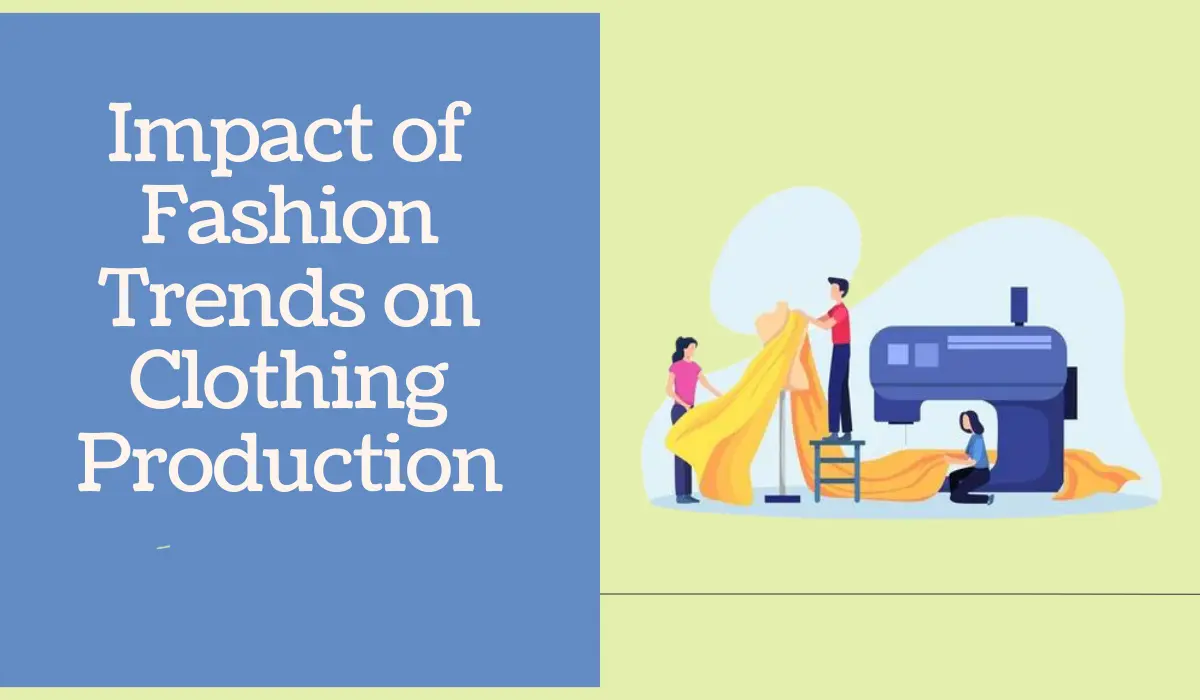- +91 9870853134
- [email protected]
Exploring the Impact of Fashion Trends on Clothing Production and Supply Chain
- By No Comments

Fashion trends serve as a powerful catalyst, driving innovation and influencing how your designers churn out new styles, right?
Owning a fashion brand requires you to stay on the top of latest trends that shape the industry. There’s no denying that fashion products and accessories are among the most personalized merchandise in the world. Innovation and design aesthetics dominate the tastes and preferences of buyers, and fashion brands keep coming up with innovative styles to stay afloat.
In an era when fresh fashion trends become old in a few months, it’s imperative to explore the impact of fashion trends on clothing production and supply chains. In 2023, the global apparel supply chain market expanded from $610 billion to $652.94 billion, recording a CAGR of 7%.
While the expanding global market holds tons of promise for fashion brands, it’s imperative to know the top trends and streamline your supply chain.
What Is Fashion Supply Chain?
The fashion supply chain encompasses a business network working together to produce apparel and accessories. It includes the entire process from sourcing raw materials to production and sales. This is a comprehensive process that includes distribution and retailing.
The different stages in the fashion supply chain are:
- Sourcing raw materials
- Conceptualizing and designing
- Manufacturing clothes
- Distribution and retailing
- Warehousing
- Fulfilment
- Sales, shipping, and customer service
With too many vendors and businesses involved, the clothing supply chain turns out to be extremely complex. Virtual clothing retailers should try to increase transparency and enhance communication at every level to streamline their supply chains. As you refine your supply chain management, your revenue streams keep flowing.
What Makes Fashion Supply Chain So Crucial?
Walking in the shoes of an apparel brand owner, it’s imperative to understand the importance of the fashion supply chain.
- Cost management and efficiency: A methodical supply chain goes a long way in reducing costs, optimizing the production process, and boosting the overall efficiency of your brand.
- Globalizing your merchandise: As you expand beyond domestic borders, your supply chain spans international markets. While globalizing your merchandise, your supply chain is shaped by the demand in different countries and their respective local markets.
- Reduced time-to-market: Changes in the fashion industry take place rapidly, which requires a fast response from designers. An optimized supply chain significantly cuts down the time-to-market, helping fashion brands remain competitive and relevant.
- Sustainability: As you know, the apparel industry has been under the scanner of regulators for environmental impact. With a sustainable supply chain, brands can minimize waste, curtail the consumption of energy, and ensure ethical practices during production.
Given that the global fashion supply chain works on several moving parts, it’s crucial to understand the impact of fashion trends and tweak your strategies accordingly.
Top 10 Fashion Trends and Their Impact on Clothing Production And Supply Chain
Now, let’s take a look at the emerging fashion trends and their corresponding impact on clothing production and supply chain.
#1. Fast Fashion
Fast fashion refers to the rapid production and distribution of inexpensive and trendy clothing. This category of fashion accessories is characterised by frequent changes in style and short product cycles.
Fast fashion recorded a 21% growth in the last 3 years. Given that fast fashion involves quick turnaround times, brands need to come up with efficient manufacturing techniques. An agile supply chain management is crucial to meet the changing demands of your customers.
This trend naturally pressurizes suppliers to deliver materials and components instantly. Retailers, on the other hand, need to restock their inventory frequently.
#2. Seasonal Trends
Seasonal trends involve changing preferences and styles of buyers during different seasons. Accordingly, fashion brands need to switch their offerings, like summer, winter, or spring collections.
Seasonal trends drive fluctuations in demand for specific types of clothing. Thus, manufacturers need to adjust their production schedules and inventory levels accordingly. This trend influences sourcing decisions, production planning, and budgetary strategies to ensure the timely delivery of fashion accessories to retailers and consumers.
#3. Sustainability
In recent years, the demand for sustainable fashion products has increased manifold. Sustainable fashion products significantly reduce the social and environmental impact of apparel production and consumption.
Sustainability affects the supply chain as manufacturers shift their focus to ethical sourcing, responsible manufacturing practices, and using eco-friendly materials. In this regard, it’s worth noting that sustainable clothing trends are here to stay.
In 2022, the ethical fashion market hit the $7,548.2 million mark and is poised to grow at 8. 1% to reach $11,122.2 million in 2027.
#4. Digitalization
The eCommerce fashion industry is rapidly expanding with the inception of digital marketing channels. With digital showrooms, virtual try-on tools, and AI, online fashion retailers are reshaping the experience of buyers. Naturally, they are looking forward to streamlining their supply chain operations to enhance the shopping journey.
#5. Personalization
Since fashion products are highly customized, retailers in the virtual space have shifted their focus on fulfilling individual preferences and sizing requirements. Thus, fashion manufacturers need to tweak their supply chains and ensure adequate flexibility in the production process.
This justifies the success of online fashion brands catering to on-demand orders. This trend influences production planning, inventory management, and distribution logistics to ensure timely delivery of customized products.
#6. Inclusivity and diversity
Innovative fashion brands have been prioritizing inclusivity and diversity in recent years. Fashion consumers around the world celebrate different body types, genders, and cultural identities. For instance, the demand for plus size apparel has picked up traction in India. Naturally, forward-thinking fashion brands continually adjust their supply chains to make room for innovative designs and marketing.
Inclusivity and diversity significantly influence product design, sizing options, and marketing strategies. This trend also fuels demand for different models that require specialized advertisement campaigns, thereby affecting the supply chain. Even retail outlets and design studios need to tweak their representations as they prioritize inclusivity and diversity.
#7. Technological Innovations
Of late, technology has been significantly influencing fashion trends. Take the instance of AI, which now plays a significant role in different stages of apparel production. Machine learning and computer vision technologies are used to detect potential defects like holes, stains, and misalignments in garments and fabrics.
AI, along with image recognition, also inspects the designs and patterns of fabrics such as logos, embroideries, and prints. The demand for artistic digital clothes designed with generative AI is on the ride.
Top apparel brands have been strategic while managing their supply chains, enabling digitization, automation, and data-driven decision-making. This trend has led to reduced lead times and increased efficiency, thereby improving visibility in supply chains. Fashion distributors can now respond quickly to customer demands and boost their bottom line.
#8. 3D printing
The apparel industry has witnessed the inception of 3D printing. This creates intricate shapes, complex designs, patterns, and textures through CAD technologies. Some of these designs are practically impossible to create using traditional methods.
On the other hand, 3D printing reduces energy, waste, and emissions as manufacturers produce apparel on demand. This does away the need for inventory accumulation and prevents excess materials from being stored.
Fashion brands, in an effort to make room for such changes in the production and distribution process, need to tweak their supply chains.
#9. Robotics
Robotics has been a boon for several industries, including fashion. Fashion brands have automated different processes in the manufacturing mechanism, including cutting, sewing, and fulfilling orders. Robotics has significantly streamlined the production of clothes and fashion accessories, minimizing the requirement for human labour. For instance, robotic sewing machines are capable of producing sophisticated garments with unprecedented speed and accuracy. This minimizes errors, besides boosting productivity.
Even logistics management has evolved significantly in the fashion industry with the inception of robotics. Large warehouses and distribution centres use robots for picking and packing orders, thereby boosting accuracy and the speed of order fulfilment.
Eventually, robotics help manufacturers and distributors optimize their operations and reduce costs.
#10. Biotechnology
In the global fashion industry, biotechnology is one of the emerging trends. The demand for bio-based apparel is on the rise, and start-ups are using living creatures to cultivate textiles in laboratories with minimal impact on the environment.
Biotechnology also makes fabrics versatile, with bio-engineered dyes and silk-inspired proteins. Particularly, algae and bacterial dyes go a long way in reducing pollution and the usage of water. The clothing, on the other hand, turns out to be skin-friendly. With biotechnology-based clothing, fashion brands take a step forward to ensure sustainability.
Why Do Fashion Trends Evolve Over Time?
You must have noticed that fashion trends keep evolving over time, and often exhibit a cyclical nature. From time to time, certain styles and aesthetics keep resurging. Accordingly, you need to make changes in your supply chain and make room for the fresh tastes of your consumers.
As a fashion brand owner, it’s imperative to understand that these trends change in response to societal values and cultural norms. It reflects the changing attitudes of your audience towards their outlook, identity, gender, inclusivity, and sustainability.
Wrapping Up
With data analytics in the fashion industry offering valuable insights into future trends based on historical data and contemporary events, manufacturers can make informed decisions while managing their inventories.
Forecasting fashion trends is a pivotal task since it helps you align your production with fashion trends. Once you accurately feel the pulse of your customers and map production cycles accurately, trend forecasting can strengthen your bottom line. Streamline your supply chain management to detect cultural shifts and changing behaviour of consumers to optimize productivity.

About Author
Fahad Khan is a Product Manager at Ubuy Technologies. Content marketing, PPC, email, and social media marketing are among his areas of expertise. He enjoys working on different niches and creating valuable content for readers.


